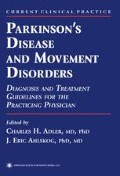Abstract
Idiopathic parkinsonism, or Parkinson’ s disease (PD), is a neurodegenerative disorder of middle and late life with a well-defined morbid anatomy, a specific pattern of biochemical pathology, and an unknown cause. Its name immortalizes Dr. James Parkinson, the British physician whose classic 1817 monograph, Essay on the Shaking Palsy, is unrivaled as a lucid and timeless description of the cardinal symptoms and signs of what is now recognized as one of the most common neurologic disorders in the Western world.
Access this chapter
Tax calculation will be finalised at checkout
Purchases are for personal use only
Preview
Unable to display preview. Download preview PDF.
Selected Reading
Gibb WRG, Lees AJ. Pathological clues to the cause of Parkinson’ s disease, in Movement Disorders(Marsden CD, Fahn S eds), 3rd ed, Butterworth-Heinemann, Oxford, 1994, pp. 147–166.
Marsden CD. Neurophysiology, in Parkinson’s Disease( Stern GM ed), Johns Hopkins University Press, Baltimore, 1990, pp. 57–98.
Marsden CD. The mysterious motor function of the basal ganglia: the Robert Wartenberg Lecture. Neurology 1982; 32: 514–539.
Stern MB. Contemporary approaches to the pharmacotherapeutic management of Parkinson’s disease: an overview. Neurology1997; 49 Suppl 1: S2 - S9.
Uhl GR. Hypothesis: the role of dopaminergic transporters in selective vulnerability of cells in Parkinson’s disease. Ann Neurol1998; 43: 555–560.
Wichmann T, DeLong MR. Physiology of the basal ganglia and pathophysiology of movement disorders of basal ganglia origin, in Movement Disorders: Neurologic Principles and Practice( Watts RL, Koller WC eds), McGraw-Hill, New York, 1997, pp. 87–97.
Editor information
Editors and Affiliations
Rights and permissions
Copyright information
© 2000 Springer Science+Business Media New York
About this chapter
Cite this chapter
Hurtig, H. (2000). What Is Parkinson’s Disease? Neuropathology, Neurochemistry, and Pathophysiology. In: Adler, C.H., Ahlskog, J.E. (eds) Parkinson’s Disease and Movement Disorders. Current Clinical Practice. Humana Press, Totowa, NJ. https://doi.org/10.1007/978-1-59259-410-8_3
Download citation
DOI: https://doi.org/10.1007/978-1-59259-410-8_3
Publisher Name: Humana Press, Totowa, NJ
Print ISBN: 978-1-61737-095-3
Online ISBN: 978-1-59259-410-8
eBook Packages: Springer Book Archive

